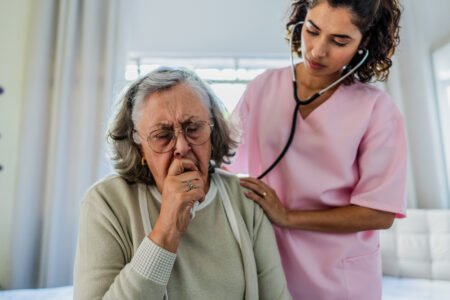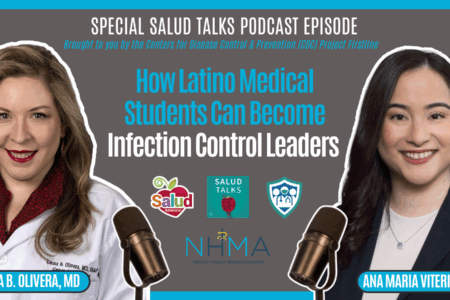
Share On Social!
Different viruses are spread in different ways.
The main way that SARS-CoV-2, the virus that causes COVID-19, spreads between people is by respiratory droplets.
“In this case, a ‘droplet’ doesn’t just mean water that you can see, like big raindrops or splashes in the sink or a pool,” said Dr. Abigail Carlson, an infectious diseases physician with the Centers for Disease Control & Prevention (CDC), as part of CDC Project Firstline’s Inside Infection Control video series. “These droplets we’re talking about are actually really tiny, and where they come from may surprise you.”
Where Do Respiratory Droplets Come From?
You might think that when you breathe out, all that comes out is air.
But our breath contains water too, in the form of respiratory droplets. You usually can’t see these droplets, but they are visible sometimes, such as when it’s cold outside and you see your breath, or you breathe on a mirror and it fogs up, or if you wear glasses and they fog up while wearing your mask.
“What you’re seeing in all these cases is not air,” Dr. Carlson said. “It’s all the water in your breath. Those are your respiratory droplets.”
It’s easy to forget that you’re always letting out respiratory droplets when you can’t always see them.
However, it’s important to remember that even when we can’t see them, we are constantly letting out respiratory droplets through simple actions like breathing and talking.
How Big Are Respiratory Droplets?
All respiratory droplets are small.
But not every droplet is the same size – as we know, most droplets are too small for us to see, but sometimes we can see them, like when someone sneezes.
Droplets travel different distances based on their size, air currents in the environment, and how strongly they come out. For example, if you cough, the droplets might travel farther.
Knowing that respiratory droplets are different sizes is helpful for understanding why we do some of the infection control actions we do in healthcare.
How Do Respiratory Droplets Spread and Infect?
Respiratory droplets are small and light enough that if we’re close to another person and not wearing a mask, we can breathe in the droplets that they just breathed out.
For example, this could happen while sitting at a table eating with friends or talking to a patient who is not wearing a mask.

When someone is infected with SARS-CoV-2, those respiratory droplets have virus particles inside of them. If you breathe in those droplets, those virus particles can then get into your throat or lungs. They can also land on your eyes and get into your body that way.
“Like many other respiratory viruses, SARS-CoV-2 is able to get into a lot of cells in our nose, our throat, our eyes, and our lungs, and when that happens, the virus can then hijack the cells,” Dr. Carlson said. “And that’s how we get sick with COVID-19.”
What Can You Do to Promote Infection Prevention and Control?
A lot of our infection control actions for COVID-19 focuses on keeping respiratory droplets out of the air and away from people, so they do not get into someone’s eyes, nose, or mouth and make them sick.
Healthcare workers can access more information about infection prevention and control in healthcare by visiting resources from CDC Project Firstline.
Project Firstline creates resources, including videos and shareable images, web buttons, posters, and print materials. They also have facilitator toolkits to help workers lead trainings even if they are not an infection control expert.
Salud America! at UT Health San Antonio is working with the National Hispanic Medical Association to bring Project Firstline infection control educational content to healthcare workers, so they are equipped with the knowledge they need to protect themselves, their facilities, and their patients (Latinos and all communities) from infectious disease threats in healthcare settings.
You can read these articles:
- What is Project Firstline?
- What is a Virus?
- What is the Goal of Infection Control in Healthcare Settings?
- How Does Infection Control Work on COVID-19 Variants Like Omicron?
- The Intersection of Infection Prevention and Control and Healthcare Equity
- Contact Time: What is It and How Does it Impact Infection Control?
- We Need to Talk about Hand Hygiene Again
- The Surprising Difference Between Cleaning and Disinfection
“Healthcare teams in hospitals, nursing homes, and other care settings are the front lines against the spread of infection,” said Dr. Amelie G. Ramirez, director of Salud America! at UT Health San Antonio. “CDC’s Project Firstline is bolstering those efforts by developing evidence-based tools that can be delivered in a variety of ways to make infection control learning convenient and accessible for busy healthcare staff.”
Learn More about Project Firstline!
Editor’s Note: This article is part of a collaboration between Salud America!, the National Hispanic Medical Association, and the CDC’s Project Firstline. To find resources training materials, and other tools to bolster knowledge and practice of infection control, visit Project Firstline and view Salud America!’s infection control content.
By The Numbers
142
Percent
Expected rise in Latino cancer cases in coming years



